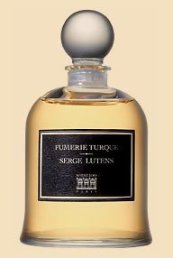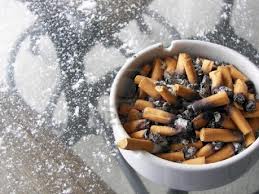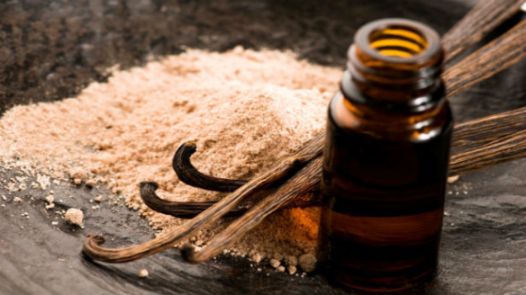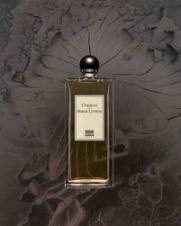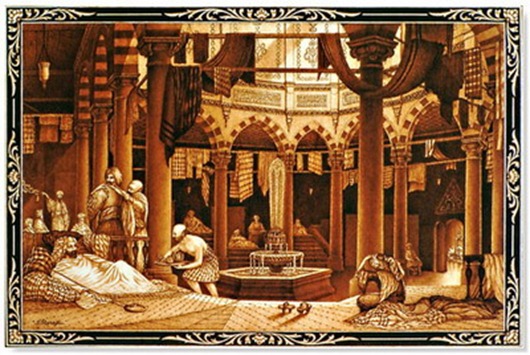I had high hopes for this one. Very high hopes. Smoke, tobacco, leather, vanilla, and spice. The famous, beloved Chergui supposedly ratcheted up a notch. Turkish rose, smoke, and honeyed pipe tobacco in a sensuous, opulent, oriental fragrance done by Uncle Serge and that mad wizard, Christopher Sheldrake. Well, not on my skin….
Fumerie Turque is an eau de parfum that was created by Serge Lutens‘ favorite perfumer, Christopher Sheldrake, and released in 2003. Though it is primarily an expensive Paris Bell Jar perfume that is exclusive to Serge Lutens’ Paris headquarters, Fumerie Turque came out at some point in a regular, cheaper, import-version, 1.7 oz/50 ml bottle that is still sometimes available online. And, somewhere along the line, the fragrance was reformulated — quite drastically, according to some — to become a softer, less tobacco-centered, more vanillic, sweet fragrance. My sample is of the current version, and it leads me to wonder what on earth it must have been like before.
Serge Lutens describes Fumerie Turque on his website as follows:
Smoking can kill you.
That’s one reason why I like using leafy blond tobacco as a raw material together with honey, underpinned with a few, slightly obscured hints of rose petal.
For some reason, Fragrantica has two entries for Fumerie Turque. There is no indication of which is the entry for the current version, and each lists slightly different notes. I haven’t seen that before, even for reformulated fragrances. Whatever the explanation, if one compiles both versions, the notes in Fumerie Turque would seem to include:
white honey, candied Turkish rose, juniper berries, chamomile, Egyptian jasmine, smoked leather, beeswax, Balkan tobacco, red currants, Peru balsam, patchouli, tonka, styrax, suede, and vanilla.
Fumerie Turque opens on my skin with smoke, vanilla, leather and spices. The fragrance is dominated by styrax, a resin which has a very dry, smoky, spicy, leathery nuance. It infuses everything it touches, including the rose note which starts out being sweet, but which quickly turns dry and smoky. Alongside are tobacco curls, nestled amidst sweet vanilla and a light touch of vanillic powder. In the background is the faintest chilly touch of a woody, pine note that feels syrupy and resinous, almost as if it were juniper resin instead of juniper berries. Wafts of a floral, slightly tea-like note flit about, as if the chamomile has been infused with the same, spicy, chewy, dense styrax as everything else.
There is something a little bitter and sour about the blend, despite the sweet, smoky, somewhat leathery notes underneath. It must be the honey with its slightly sulphurous undertones. Honey is an extremely tricky note for some people, as their skin chemistry can turn it sour, urinous, skanky, animalic, raunchy, or some combination thereof. I happen to be generally lucky with the element, which I adore, even on those rare occasions when it can feel almost sulphurous as it does here. But, I must say, I am not at all keen about its sour nuances in Fumerie Turque. I’m even less enthused as it gets worse, quickly turning into a smell that is simultaneously stale, sour, bitter, sharp, acrid, and, eventually, almost rancid in feel. The beautiful, sweet, freshness of the rose has receded along with the vanilla, its powder, the juniper berries, and the dark, tea-like chamomile, leaving the harsher, animalic notes utterly untamed. Rank bitterness is what comes to mind, and I imagine that people who traditionally have always had problems with honey might fare even worse.

Leather Tanning in Morocco. Photo by Burrard-Lucas via http://www.burrard-lucas.com/photo/morocco/leather_tanning.html
Ten minutes into Fumerie Turque’s development, those harsher notes become extremely prominent. The leather feels almost raw, like tannery hides left to cure in the sun. There is a tarry, animalic, phenolic, musky sharpness to the smell. And the rank sourness of the honey now feels quite rancid. Making matters worse is the tobacco, a note I normally love. Here, it feels neither like dried tobacco leaves, nor like sweet, fruited, honeyed pipe tobacco. Instead, it smells like a stale, dirty ashtray with the remnants of a few, old cigars.
To be honest, I’m somewhat appalled by the overall combination: urinous, sulphurous, rancid honey with raw leather and stale ashtray smoke is really not my cup of tea. Not even the occasional flickers of rose and vanilla which pop up and down, going back and forth from the background to the foreground, can fix the stale, sour, bitter, animalic pungency emanating from my arm. And, have I mentioned the word “rancid” yet? I once had the misfortune of cleaning a friend’s fridge which had been left untouched for over a year; the smell of the rotten eggs had a similar sulphurous, smoky rancidness. Only here, they’re mixed in with a disconcerting stale sweetness. I know the horrible bouquet is due purely and solely to my skin’s chemistry — just as I know that others may (and do) have a wholly different, extremely positive scent sensation with this much admired fragrance — but I can only recount my own experiences and, thus far, it’s revolting. I’ve never, ever had honey go south on me… until now!
Fumerie Turque continues in that painful vein for a while. The vanilla makes every valiant attempt to come to the foreground to soften things, and once in a while, it actually succeeds. It’s short-lived, however, as the rancid sourness marches on like a Turkish army hell-bent on whipping me into submission. Thirty minutes into Fumerie Turque’s progression, beeswax joins the Devil’s Brigade, mocking me with yet another, additional layer of sourness. The animalic, almost dirty, raw leather, and the stale tobacco ashtray aromas join in, cackling gleefully at the faint whimpers that are starting to emanate from my miserable little self. I look at the Fumerie Turque’s longevity rankings on Fragrantica (“very long lasting” say the majority), mutter some expletives, and contemplate sending dear Uncle Serge a “Dear John” letter. I also wonder if it’s too early to start drinking.
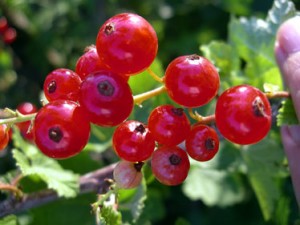 Close to the end of the second hour, Fumerie Turque decides to take some pity on me. It starts to soften, becoming milder, less feral and brutal. The leather, ashtray and honey elements take on a rounder, less intentionally hostile and aggressive edge, though their undertones retain that rancid stench that is still too bloody sharp and acrid for my tastes. Thankfully, the sillage has dropped from its previously potent levels, making me hope that Fumerie Turque has decided to engage in an olfactory cessation of hostilities. Er… not quite. We are now launching into a whole new sort of merciless madness. At the 2.5 hour mark, Fumerie Turque turns into a strange mélange of vaguely sour, vanillic baby powder infused with the odd tartness of red currants berries, atop a base of light, sweet smoke and somewhat treacly rose. I sighed so deeply, you have no idea, and wonder what Uncle Serge would think of a blotchy, tear-splattered letter.
Close to the end of the second hour, Fumerie Turque decides to take some pity on me. It starts to soften, becoming milder, less feral and brutal. The leather, ashtray and honey elements take on a rounder, less intentionally hostile and aggressive edge, though their undertones retain that rancid stench that is still too bloody sharp and acrid for my tastes. Thankfully, the sillage has dropped from its previously potent levels, making me hope that Fumerie Turque has decided to engage in an olfactory cessation of hostilities. Er… not quite. We are now launching into a whole new sort of merciless madness. At the 2.5 hour mark, Fumerie Turque turns into a strange mélange of vaguely sour, vanillic baby powder infused with the odd tartness of red currants berries, atop a base of light, sweet smoke and somewhat treacly rose. I sighed so deeply, you have no idea, and wonder what Uncle Serge would think of a blotchy, tear-splattered letter.
Fumerie Turque continues its descent into powdery, smoke-tinged sweetness. It’s quite a relief, given what came before. Close to the end of the fourth hour, there is more vanillic baby powder, tart fruit notes, whispers of smoke, and a definite subtext of honeyed sourness. The new addition, however, is beeswax — and it’s the only part of the somewhat muted, faded combination that I find pleasant. Around the middle of the fifth hour, Fumerie Turque fades into abstract, powdery vanilla with honey and a whisper of beeswax, and remains that way until the end. All in all, Fumerie Turque lasted just short of 6.75 hours, which is much less than the enormous longevity that I had braced myself for. On average, the sillage was moderate: very forceful in terms of projection for a brief period at the start, but then, significantly softer while still being noticeable within the tiny bubble that wafted an inch above my skin.
Normally, with fragrances that take such a terrible turn on my skin, I would give the perfume two tests. Sometimes, maybe even three. I couldn’t do it with Fumerie Turque. I simply couldn’t. It wasn’t only that extremely difficult opening but, rather, how exhausting the progression was in its forcefulness and in the unalleviated monotony. Fumerie Turque isn’t linear from start to finish but, within its two distinct stages, it certainly feels a little singular. I always say that there is nothing wrong with linear fragrances if you love the notes in question but, obviously, that was not the case here.
There are a few reasons why I’m so incredibly disappointed with the manner in which Fumerie Turque manifested itself on my skin, beyond the really obvious ones, that is. First, many people consider the fragrance to be the more advanced, complex, sophisticated brother to Serge Lutens’ Chergui. Fumerie Turque is supposed to be richer, smokier, less vanillic or powdery (in both its original and reformulated version, presumably) than the fragrance that I own and love. It seemed indubitable that Fumerie Turque would be even more up my alley.
Second, Fumerie Turque seemed very familiar upon first sniff of the fragrance in the vial. It instantly and immediately brought to mind one of my favorite comfort scents, the superb Karl Lagerfeld Cologne in vintage formulation. Karl Lagerfeld’s 1980s beauty is actually the sole reason I started this blog. I needed a place to properly express my love for this fragrance when I reacquired a bottle on eBay, and I couldn’t do it in a Facebook status post, though I certainly spent a good few paragraphs trying. My very first perfume review was, in fact, a rushed, hurried, rather short affair on the joys of Karl Lagerfeld’s interpretation of and homage to Shalimar. A few parts of that review:
Imagine your boyfriend’s leather jacket, covered with honey, and in an old Russian or Greek Orthodox church filled with smoky incense and the whiff of a passerby in rose and jasmine…. this is better. If there were a honey seller in a stall sandwiched between a musky spice vendor of nutmeg, tarragon and anise, and one who sold sweetly fragrant tobacco that your uncle put in his pipe — all in a giant leather store filled with the finest British leather saddles, which was in a Turkish bazaar… this is better.
[…] Some say that it’s like a male-version of Shalimar and I suppose it’s the faint touch of powder in it. But if Meryl Streep wears Shalimar (and she does), then Tina Turner would wear this. If Shalimar is a Rolls Royce, this is James Bond’s Aston Martin or perhaps a BEAST of a muscle car driven by a Russian Orthodox monk in a leather jacket. That’s it! This is the smell for Rasputin, though one commentator elsewhere said that they thought Robert Redford in the Great Gatsby would wear this. I disagree. This is pure leather smoke covered with honey.
And….. it’s sex on a stick. […] Just be warned, it’s not for the faint of heart and that, depending on your body chemistry, powder may predominate over leather, tobacco or honey. Also, if you’re not into powerful scents, do not put on more than one spray.
Not a week goes by that I don’t regret the brevity of that article (relative to my usual verboseness). Not a week passes that I don’t vow to do the perfume proper justice with a revisit. Karl Lagerfeld Cologne has been a favorite fragrance of mine for over two decades — and Kafkaesque exists purely and solely because of it.
That fragrance is what I immediately came to mind when I took a gandering sniff of Fumerie Turque in the vial: a richer, smokier, drier, less powdery, less sweet Karl Lagerfeld. I couldn’t believe it. My jaw dropped, and I couldn’t wait to try it on the skin. Later, much later, after the bloody, leathery, stale, rancid chum in Fumerie Turque’s shark-infested waters had faded away, I was surprised to discover that I wasn’t the only one who thought there were similarities between the two fragrances. A passing, brief comment on a Basenotes thread devoted to Fumerie Turque said: “When I read these threads, I wonder how many who enjoy FT have tried the original Lagerfeld Cologne (before it became “Classic”).” I have no idea who the poster, “Bigsly,” is, but I want to give him a hearty Bravo for unknowingly reassuring me that I’m not insane (and, also, for his excellent taste). Because, yes, when I read positive descriptions of Fumerie Turque on Fragrantica, they sounds a bit like what I experience with Karl Lagerfeld.
There are significant differences, however. The Karl Lagerfeld is much sweeter, more vanillic, and more powdery than the largely acrid Fumerie Turque. It has a bergamot, citric, and subtle, vaguely herbal element to its beginning. More importantly, the leather is very different in Karl Lagerfeld; it lacks the raw, animalic outbursts in Fumerie Turque, while being significantly stronger and richer than it is in Chergui. Also, the tobacco smoke is sweeter than the more acrid, stale, dirty version in Fumerie Turque, more akin to pipe tobacco, and is additionally supplemented by incense. If the Lagerfeld didn’t precede both Lutens fragrances by almost 20 years, I would call it a lovechild of Chergui and Fumerie Turque, combining the best parts of both in a much stronger, more potent, intense, powerful blast. But Karl did it first. There is also another big difference: the Lagerfeld is available in vintage form for a mere pittance on eBay. You can buy a 2 oz bottle for between $20-$30, depending on times, vendors and competing bidders. Sometimes, they can go up to $45, but I bought my bottle for about $18! The key — and this is really important — is to AVOID anything that has the word “Classic” on the bottle because that is the reformulated rubbish version! (I beg of you, don’t do it. It’s not the same at all.)
I realise that my review of Fumerie Turque has descended into an ode to Karl Lagerfeld Cologne, so let’s return to that Basenotes thread. It’s interesting because the chap had an equally brutal start to Fumerie Turque, which he bought blindly based on the positive praise for the fragrance. Though he subsequently fell in love with Fumerie Turque, I think his experience is illuminating, in part because it also references some other well-known fragrances:
I sprayed some on my bicep. OH NO!!! I REALLY SCREWED UP BUYING THIS STUFF!!! Immediately, I got this sickly powdery feminine stale urine porta-potty smell that some of the negative reviews had mentioned. Totally, totally unwearable. […] five minutes later I noticed that tobacco note– and it was actually a very nice specimen of tobacco. If only that other “pissy, honey, rose” stuff wasn’t going on…
Yet, he gave it a second shot, mostly due to the many, many raves for Fumerie Turque from people he respected. And, this time, he noticed some differences. First, there was a strong similarity between Fumerie Turque’s “beeswax and the emerging red currants/fruit” and the smell of Chanel‘s Antaeus, a fragrance that he had initially hated but then grown to love. Second, with a little time, Fumerie Turque developed into something lovely on his skin:
… the pipe tobacco was starting to come out very noticeably. I’ve truly NEVER experienced a fragrance that did such a 180 in the wearing and bloomed into something so cool. It still had a bit of that Habanita powdery quality and that dense honeybun beeswax in the base, but the tobacco was starting to steal the show in a big way. Some people call this scent “smokey” but thankfully, it’s not smokey to my nose– at least not in a negative manner. The first time I smelled it, it did conjure the back room of a bar where there had probably been a lot of second hand smoke, but once it started to blossom, it was smooth and ethereal. Again the beeswax is right there in the beginning and it almost makes you nauseous, but it only takes about two minutes for the composition begin unfolding into what it will become. As time goes on, the scent becomes more “blonde” as in blonde tobacco, and begins to feel lighter, but not lesser.
To compare this to a tobacco scent like Pure Havane almost makes me laugh now. I like Pure Havane a hell of a lot, don’t get me wrong– but this stuff is on a whole different level. This is adult, it’s grown up seduction in a bottle. Pure Havane is the most playful, fun tobacco scent I’ve tried, but Fumerie Turque is not for children. […]
What Fumerie Turque is, is an ACTUAL PERFUME. […] Christopher Sheldrake has created a real masterpiece here. Top to bottom. Something that relies on a little necessary chaos out of the bottle to get on its feet, but once it does, and starts walking upright, god it’s beautiful. [Emphasis in bold added by me to the perfume names.]
There are numerous gushing, quite poetic raves about Fumerie Turque on Fragrantica (where it is enormously loved in both of the perfume’s listings), but I chose that particular Basenotes review for a reason. It highlights how some people can have a very positive experience with Fumerie Turque at the end, despite the sour, “pissy” start.
It also shows that, as many Basenotes commentators agree, Fumerie Turque is a perfume that can sometimes take a few tries. A number of Lutens fragrances require patience but, given the trickiness of honey as a note, Fumerie Turque may require more patience than most. In all candour, if I didn’t already have my beloved Karl Lagerfeld and Chergui, I probably would have given Fumerie Turque the necessary second chance that so many people say it requires, especially as I found some of the vintage bottles (which are supposed to be far better than the current version) available online for a significantly cheaper price than the current Bell Jar formulation. But I do have Lagerfeld and Chergui, so I’m not hugely motivated. Plus, there is also the simple reality that some honey fragrances never work out on a person’s skin, no matter how many chances you give them.
Would I recommend that you give Fumerie Turque a shot? Well, never as a blind buy, no. However, if you love Chergui, then yes, by all means, give Fumerie Turque an exploratory sniff. Get a sample, see if it works for you, and, if you love it, then you can get the more affordable vintage version that I’ve found on some of the online retailers below. (Actually, I would highly recommend the Karl Lagerfeld above all else, especially if powder notes don’t go south on your skin.) On the other hand, if you don’t love Chergui, or if you already know for a fact that honey is always one of your fatal notes, then I would advise that you stay clear of Fumerie Turque entirely. If it didn’t work on my honey-loving skin, I can’t imagine how badly it might turn out for those who never have any luck with the note. I suspect you’d end up in a foetal position, crying for a Silkwood shower….


